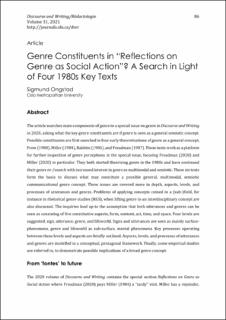| dc.description.abstract | The article searches main components of genre in a special issue on genre in Discourse and Writing in 2020, asking what the key genre constituents are if genre is seen as a general semiotic concept. Possible constituents are first searched in four early theoretisations of genre as a general concept, Frow (1980), Miller (1984), Bakhtin (1986), and Freadman (1987). These texts work as a platform for further inspection of genre perceptions in the special issue, focusing Freadman (2020) and Miller (2020) in particular. They both started theorising genre in the 1980s and have continued their genre re-/search with increased interest in genre as multimodal and semiotic. These six texts form the basis to discuss what may constitute a possible general, multimodal, semiotic communicational genre concept. Three issues are covered more in depth, aspects, levels, and processes of utterances and genres. Problems of applying concepts coined in a (sub-)field, for instance in rhetorical genre studies (RGS), when lifting genre to an interdisciplinary concept are also discussed. The inquiries lead up to the assumption that both utterances and genres can be seen as consisting of five constitutive aspects, form, content, act, time, and space. Four levels are suggested, sign, utterance, genre, and lifeworld. Signs and utterances are seen as mainly surface-phenomena, genre and lifeworld as sub-surface, mental phenomena. Key processes operating between these levels and aspects are briefly outlined. Aspects, levels, and processes of utterances and genres are modelled in a conceptual, pentagonal framework. Finally, some empirical studies are referred to, to demonstrate possible implications of a broad genre concept. | en_US |

